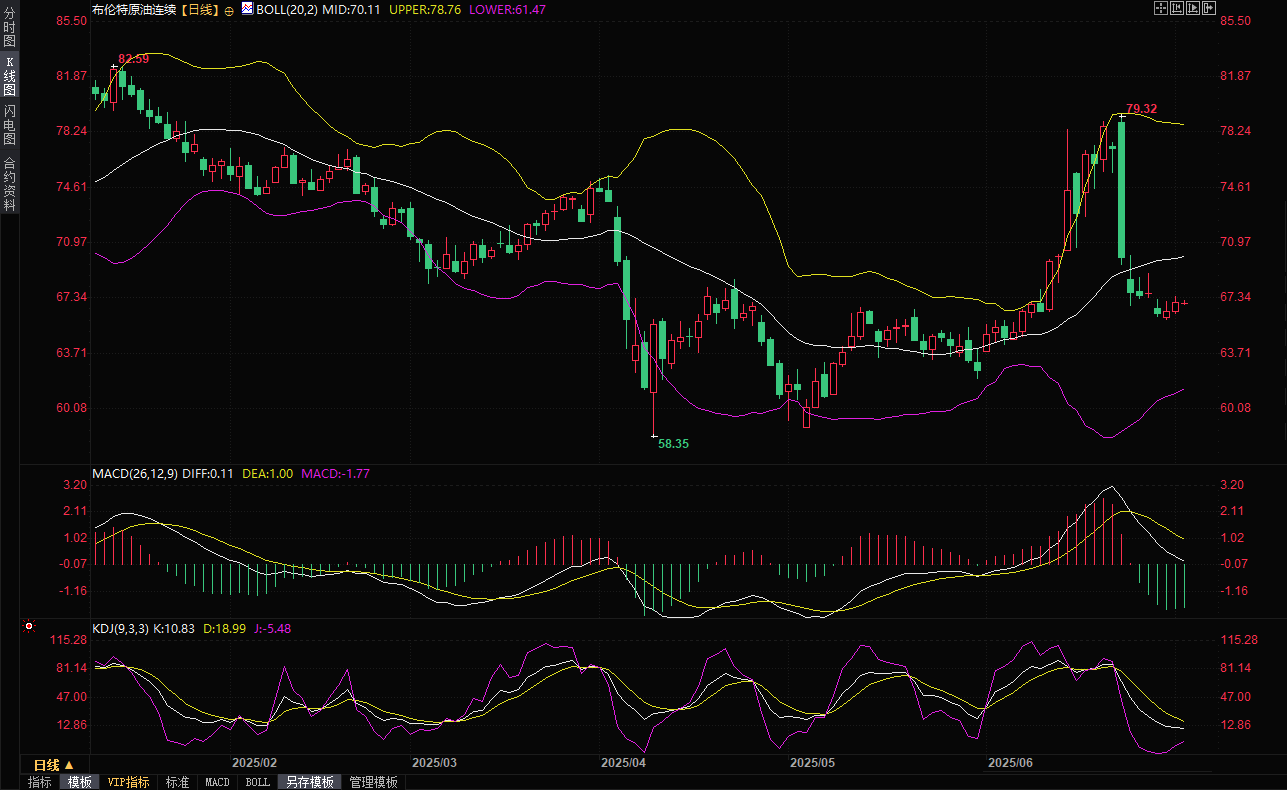The interweaving of long and short factors and the delicate balance in the market game have caused oil prices to fluctuate in a narrow range.
2025-07-02 15:29:53

Geopolitical easing: The situation in the Middle East is no longer a "bomb"
Since Iran and Israel stopped attacking each other after 12 days of conflict, market concerns about oil supply disruptions in the Middle East have significantly eased. As an important oil producing region in the world, any disturbance in the situation in the Middle East may cause sharp fluctuations in oil prices.
However, since June 25, Brent crude oil prices have been fluctuating between a high of $69.05 and a low of $66.34 per barrel, showing that market concerns about geopolitical risks have been largely priced in.
Analysts point out that unless a major conflict breaks out again in the Middle East, geopolitical factors will have a limited impact on oil prices in the short term.
US inventory data: Unexpected increase triggers pressure
According to data from the American Petroleum Institute (API), U.S. crude oil inventories unexpectedly increased by 680,000 barrels last week. Normally, summer is the peak season for oil demand, and inventories should show a downward trend. This unexpected increase has undoubtedly brought downward pressure on oil prices.
Priyanka Sachdeva, senior market analyst at Phillip Nova, said the unexpected performance of the inventory data was intertwined with expectations that OPEC+ might increase supply, further exacerbating market uncertainty.
Investors are waiting for official inventory data from the U.S. Energy Information Administration (EIA) to be released at 22:30 on Wednesday evening Beijing time to further judge supply and demand trends.
OPEC+ production increase plan: Has the market become “immune” in advance?
The movement of the Organization of Petroleum Exporting Countries and its allies (OPEC+) has always been a barometer of oil price trends. According to four OPEC+ sources, the organization plans to decide to increase daily production by 411,000 barrels at its meeting on July 6. This production increase plan has long been widely circulated in the market, and investors seem to have digested this expectation in advance.
Sachdeva analyzed that the news of OPEC+'s production increase is unlikely to cause new shocks to the market in the short term, but in the long run, increased supply may put continued pressure on oil prices, especially in the context of uncertain prospects for global economic recovery.
Weak dollar: a lifeline for oil prices
Among the many negative factors, the weakening of the US dollar exchange rate provided some support for oil prices. The US dollar fell to a three-and-a-half-year low against major currencies on Tuesday, and only rebounded modestly on Wednesday, remaining at a low level. A weaker dollar usually stimulates buyers who pay in other currencies to increase oil demand because it reduces the actual purchase cost of oil priced in dollars.
Sachdeva pointed out that against the backdrop of fading geopolitical risks and continued global economic concerns, the weakness of the U.S. dollar has become the "only exceptional factor" supporting the upward trend in oil prices. However, the sustainability of this support remains to be seen, as the trend of the U.S. dollar is greatly affected by the Federal Reserve's monetary policy.
Fed policy and non-farm data: the “barometer” of oil prices
The market has never stopped paying attention to US economic data, especially the US non-farm payrolls data to be released on Thursday. This data will directly affect the market's expectations on the extent and timing of the Fed's interest rate cut in the second half of the year.
IG analyst Tony Sycamore said that interest rate cuts usually stimulate economic activity, thereby boosting oil demand. If the non-farm data is strong, it may enhance the market's confidence in the US economic recovery, thereby pushing up oil prices; on the contrary, if the data is weak, it may further exacerbate market concerns about the global economic outlook and drag down oil prices.
Summary: Oil price trend remains uncertain
Overall, the current stable trend of oil prices is the result of multiple factors. The reduction of geopolitical risks in the Middle East, the digestion of OPEC+'s production increase expectations, the unexpected increase in US inventory data, and the weakening of the US dollar exchange rate have jointly shaped the complex market situation. In the short term, oil prices may continue to fluctuate in a narrow range. Investors need to pay close attention to the official inventory data of the EIA, non-agricultural employment data and the final decision of the OPEC+ meeting.

(Daily chart of Brent crude oil main contract, source: Yihuitong)
At 15:27 Beijing time, the main contract of Brent crude oil is currently trading at US$67.08 per barrel.
- Risk Warning and Disclaimer
- The market involves risk, and trading may not be suitable for all investors. This article is for reference only and does not constitute personal investment advice, nor does it take into account certain users’ specific investment objectives, financial situation, or other needs. Any investment decisions made based on this information are at your own risk.










